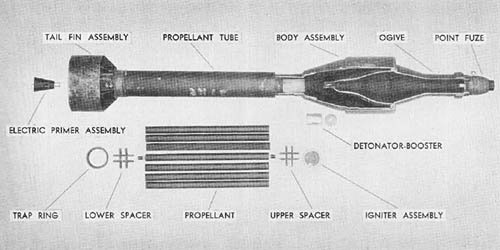
This fin stabilized rocket projectile is fired from the German counterpart of the U.S. “Bazooka” (see page 217) and has a maximum effective range of 165 yards. Eight and one-half-inch armor penetration has been obtained in static tests with a standoff of approximately 6 1/2 inches.
The complete round consists of a point fuzed high explosive, hollow charge loaded projectile assembled to a steel tube with a venturi and stabilizer assembly attached, containing an igniter, propellant and electric primer. The AZ 5095 fuze is of the point detonating type which in tests gave an approximate fuze functioning time of 0.0002 seconds (impact to detonation). The projectile assembly consists of the following stamped sheet steel parts: a body which contains the bursting charge, an adapter, a collar, a band, and a slightly heavier sheet steel nose. A detonator-booster of the German Kl. Zdlg. 34 NP type is embedded in the bursting charge to the rear of the flash tube. The bursting charge is cyclotol (41.2% TNT, 58.8% cyclonite) weighing 1 lb., 7.2 ozs. The propellant and tube assembly consists of the propellant tube and the seven propellant grains and igniter assembly, located in the forward end which it holds. The seven propellant powder grains are approximately 7.6 inches in length x .45 inch outside diameter, and have a central perforation .22 inch in diameter throughout their length. The composition is 64½% nitrocellulose and 34½% DEGN, with a small percentage of stabilizer.
A new type of ammunition, the R. Pz. B. Gr. 4999 is reported to give good performance up to a range of 220 yards, 25° C. (77° F.).
SPECIFICATIONS
| Weight (complete, rocket as fired) |
|
7.26 lbs. |
| Weight of high explosive filler |
|
1.47 lbs. |
| Weight of fuze assembly |
|
.175 lb. |
| Weight of igniter assembly |
|
.021 lb. |
| Weight of propellant charge |
|
.382 lb. |
| Length (overall) |
|
25.56 ins. |
| Diameter (external) |
|
3.437 ins. |
| Burnt velocity at 50° F. (approx.) |
|
340 f/s* |
| Burning distance (approx.) |
|
7 ft.* |
| Fuze functioning time (approx.) |
|
.0002 seconds |
| Maximum pressure |
|
6,910 lbs. per sq. in.* |
| Maximum thrust |
|
1,716 lbs.* |
| Impulse |
|
87 lbs. second** |
| Maximum effective range |
|
165 yds. |
*These figures are from firing a single round.
**These values doubtful; only one rocket motor was statically tested with propellant temperature 41° F.
German: p. 357 (August 1, 1945)
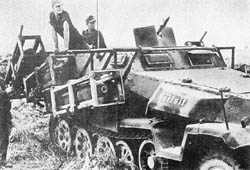 This rocket projector is designed for use on half-tracked armored personnel carriers. The principal feature of the device is the carrier plate, three of which are mounted on each side of the half-track. Each is adjustable for elevation of 5° to 45°, and is believed to be equipped with an elevating scale. The actual projector consists of the crate in which the
This rocket projector is designed for use on half-tracked armored personnel carriers. The principal feature of the device is the carrier plate, three of which are mounted on each side of the half-track. Each is adjustable for elevation of 5° to 45°, and is believed to be equipped with an elevating scale. The actual projector consists of the crate in which the 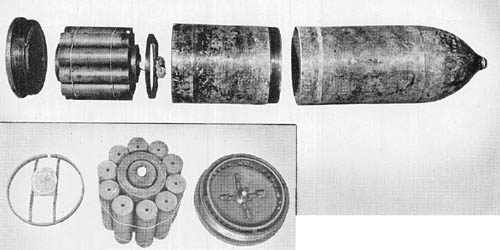
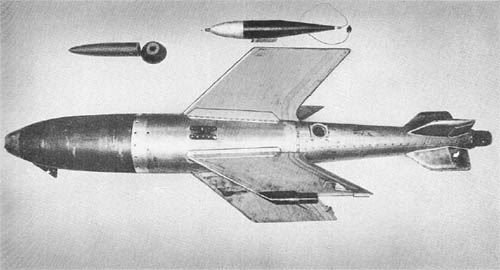
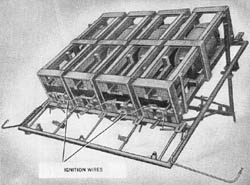 These two rocket projectors, or ramps, differ from each other only in construction details and in the material used. The Schweres Wurfgerät 40 is made of wood and weighs 115 pounds; the 41 model is of metal, weighing 243 pounds. Each is designed to carry four crates of the
These two rocket projectors, or ramps, differ from each other only in construction details and in the material used. The Schweres Wurfgerät 40 is made of wood and weighs 115 pounds; the 41 model is of metal, weighing 243 pounds. Each is designed to carry four crates of the 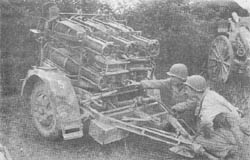 This rocket projector fires the
This rocket projector fires the 